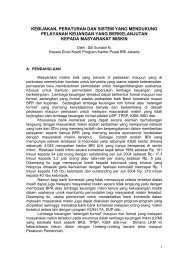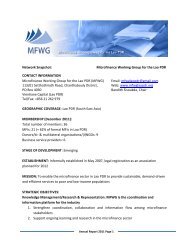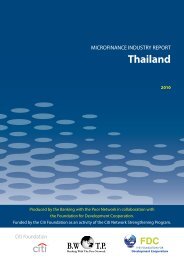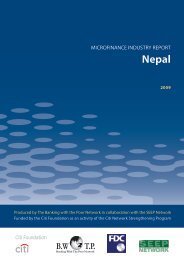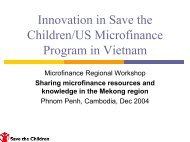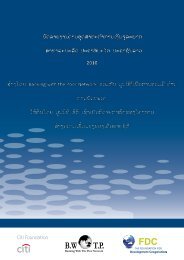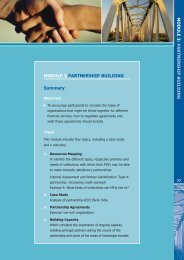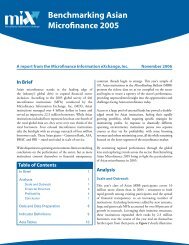PDF version - Banking with the Poor Network
PDF version - Banking with the Poor Network
PDF version - Banking with the Poor Network
You also want an ePaper? Increase the reach of your titles
YUMPU automatically turns print PDFs into web optimized ePapers that Google loves.
BWTPAsia Resource Centre for MicrofinanceVIETNAM Country ProfileIn This Document:• Needs for Microfinance• Microfinance Sector Development• Regulations and Government Initiatives• Practices• Innovations• Providers• Funding and Supporting OrganisationsVietnam is one of <strong>the</strong> fastest growing developing economies in <strong>the</strong> world. Initiated in <strong>the</strong> lateeighties, <strong>the</strong> transition from a centrally-planned to a socialist market-oriented economy hashad impressive impact on poverty alleviation. For a population of almost 82 million people,poverty was cut in half between 1993 and 2002, from 58% to 29% of <strong>the</strong> population. Duringthat period, a third of <strong>the</strong> population was lifted out of poverty, mainly due to job creation in<strong>the</strong> private sector, and reforms in <strong>the</strong> agriculture sector, more market-orientated. Howeverpoverty was reduced in a much slower pace in <strong>the</strong> central region, <strong>the</strong> poorest in <strong>the</strong> countryand <strong>the</strong> Nor<strong>the</strong>rn mountain and north central coast, while <strong>the</strong> proportion of ethnic minoritiesin <strong>the</strong> overall poor population increased. It is estimated that 85% of <strong>the</strong> poor live in ruralareas. The government has used financial services for <strong>the</strong> poor as a powerful instrument inpoverty alleviation, particularly in <strong>the</strong> rural regions. Utilizing state-owned banks, <strong>the</strong>government provides subsidized loans to poor households to achieve poverty alleviationobjectives.Needs for Microfinance• Even if considerable progress in poverty reduction has been made in <strong>the</strong> 1990s, <strong>the</strong>pace is slowing, and Vietnam is still one of <strong>the</strong> poorest countries in <strong>the</strong> world.Providing <strong>the</strong> poor <strong>with</strong> long-term access to financial services still a priority.• Despite <strong>the</strong> increasing outreach of formal financial institutions, <strong>the</strong>re are still a largenumber of poor households <strong>with</strong>out access to finance. 40% of households in Vietnamdid not have access to formal credit sources in 2001.• The formal financial sector does not provide sustainable and widespread access tomicrofinance services to <strong>the</strong> poor. The formal rural financial sector comprises fivestate-owned commercial banks, about 20 rural shareholding banks, about 900People's Credit Funds (PCFs), and about 70 credit cooperatives. The banking sectorhas a poor track record in terms of applying microfinance best practices: widespreaduse of subsidized credit, low repayment rates and poor management capacities.• Moreover, <strong>the</strong> government acts as regulator and an active participant via publicownedbanks, leading to unsustainable banking practices.• The banking sector is currently going through a restructuring phase, which includesrecapitalisation, <strong>the</strong> introduction of market-based lending, and capacity building offinancial institutions.1
Microfinance sector developmentBefore 1988, Vietnam had a mono-tier banking system, comprising <strong>the</strong> State Bank ofVietnam (SBV), playing <strong>the</strong> role of central and commercial bank, and two specializedinstitutions: <strong>the</strong> Bank for Investment and Development and <strong>the</strong> Bank for Foreign Trade. After<strong>the</strong> 1988 reforms of <strong>the</strong> financial system, SBV only focused on central bank responsibilities,and four state owned commercial banks were created, including <strong>the</strong> Vietnam Bank forAgriculture and Rural Development (VBARD). A not-for-profit Vietnam Bank of <strong>the</strong> <strong>Poor</strong>(VBP) was established in 1995, <strong>with</strong> a focus on poverty alleviation.However, financial reforms also led to <strong>the</strong> downfall of traditional credit cooperatives, and aloss of faith in <strong>the</strong> financial system from <strong>the</strong> general public. The main purpose of traditionalcredit cooperatives was to collect small deposits and provide credit to individuals, farmhouseholds, small businesses and production cooperatives. The collapse of <strong>the</strong> cooperativesystem and <strong>the</strong> establishment of credit-focused public banks, prompted <strong>the</strong> government toestablish in 1993 new People’s Credit Funds (PCFs) to mobilize domestic savings.After <strong>the</strong> reforms in <strong>the</strong> late eighties, <strong>the</strong> Hunger eradication and Poverty Reduction (HEPR),launched by <strong>the</strong> Vietnamese government in 1997 focused on improving poor people'saccess to financial services, especially in rural regions.Government-owned banks (VBARD and VBP) became <strong>the</strong> major providers of financialservices to low-income population, while PCFs focused on savings mobilization and alsocredit. Rural shareholding banks played a much smaller role.In parallel, <strong>the</strong> semi-formal sector saw <strong>the</strong> establishment of microfinance programs in <strong>the</strong>1990s, managed by international programs and NGOs, in partnership <strong>with</strong> massorganisations such as <strong>the</strong> Vietnam Women’s Union (VWU). Social funds started to specializein microfinance, such as TYM Fund (VWU) and <strong>the</strong> CEP (HCMC Labour Confederation).In 2002, <strong>the</strong> Vietnam Living Standards Survey indicated that VBP was <strong>the</strong> leadingmicrocredit provider to poor households in rural areas <strong>with</strong> 58% of <strong>the</strong> market, followed byVBARD <strong>with</strong> 24%. PCF had a 3% market share of <strong>the</strong> rural credit market, while semi-formalorganisations had a 7% share.By 2003, <strong>the</strong> formal financial sector (VBARD, VSPB, PCFs) reached approximately 7 millionhouseholds, among <strong>the</strong>m 3 million rural households, representing over 90% of <strong>the</strong> outreachof rural financial services in Vietnam.Current challenges• Without legal framework to support <strong>the</strong>m, microfinance programs have limited access tofunds and are restrained to mobilize public savings.• Savings mobilization and facilities are still underdeveloped, in a credit-focusedenvironment, sustained by public institutions and government's social and economicpolicies. Large public institutions are more interested in providing cheap credit thatmobilizing savings.• Informal and political pressures keep interest rates low, which limit <strong>the</strong> capacity ofmicrofinance programs to reach sustainability, and create an uneven playing field.• Long-term sustainability of microfinance providers in Vietnam is a major issue, <strong>with</strong>widespread use of subsidized interest rates, government supported rural banks (VBARDand VBSP) and <strong>the</strong> lack of specialization of mass organisations and o<strong>the</strong>r NGOprograms.2
• O<strong>the</strong>r constraints for <strong>the</strong> growth of microfinance programs are staff capacity (in businessand financial management), and limited access to training and institutional capital.• There is no formal network in microfinance, which could be used to provide capacitybuilding assistance, information sharing and advocacy services.Regulations and government initiativesRegulationsThere is still no comprehensive legal framework covering microfinance activities in Vietnam,as <strong>the</strong> semi-formal sector falls outside <strong>the</strong> existing law on credit institutions. In consequence,most microfinance activities are developed under projects implemented by governmentministries, mass organisations, and international NGOs. The lack of legal framework meansthat <strong>the</strong> transition from projects to independent microfinance institutions is still impossible.The only choices are joining <strong>the</strong> PCF network or establishing a fund, which gives a certaindegree of autonomy, but no real independence, and no legal basis to mobilise savings.An exception to this rule was made in January 2000, when SBV officially allowed <strong>the</strong> VWU tooperate credit and savings schemes in pursuing its goal of poverty eradication. However,o<strong>the</strong>r social organisations are also mobilising saving <strong>with</strong>out explicit legal support.The unclear regulatory framework for microfinance has been a major impediment for <strong>the</strong>development of <strong>the</strong> microfinance sector in Vietnam, <strong>with</strong> investors and donors reluctant toenter <strong>the</strong> sector.The ADB has supported <strong>the</strong> development of a draft decree on <strong>the</strong> regulation and supervisionof microfinance. The document supports <strong>the</strong> development of a market-oriented formalsector, consisting of regulated banks and Microfinance Institutions (MFIs), and supportingbest practices principles such as sustainability of institutions, performance targets, goodgovernance and application of accounting principles.The draft decree proposes that NGOs and o<strong>the</strong>r social organisation be allowed to establishindependent microfinance institutions in Vietnam under an operating licence delivered by <strong>the</strong>State Bank of Vietnam. Capital requirements for MFIs providing credit and requiringcompulsory savings is fixed at 500 million VND (US$32,000), while MFIs offering voluntarysavings services it is fixed at 5 billion VND (US$320,000). Licenses are provided foroperations at provincial level, and do not have national coverage. The draft decree mentionsthat <strong>the</strong> State Bank of Vietnam will supervise licensed MFIs, and provide additionaldirectives on savings to loan ratios, extensions of licenses and reporting.It is said that <strong>the</strong> decree is in <strong>the</strong> last stage of review by government offices and ministries.The lack of study of <strong>the</strong> semi-formal financial sector, and <strong>the</strong> potential impact of microfinanceregulations on <strong>the</strong> overall financial system seem to be <strong>the</strong> last barriers to its finalisation.Once enacted, <strong>the</strong> decree is likely to make a substantial change in <strong>the</strong> microfinancelandscape in Vietnam by promoting sound and transparent microfinance practices, byencouraging donors, banks and investors to support microfinance providers, and bydeveloping savings mobilisation.Government initiativesSubsidised credit programs managed by government departments and public banks distort<strong>the</strong> financial market and prevent <strong>the</strong> development of sustainable microfinance in Vietnam.Even if credit institutions (since 2002) are free to set <strong>the</strong>ir own interest rates (<strong>with</strong> <strong>the</strong>3
exception of VSPB), in practice, only a limited number of organisations charge market-basedinterest rates.As part of government initiatives, <strong>the</strong> two state-owned banks, VBARD and VBSP, providesubsidized credit to targeted poor households. VBSP was specifically established to providesubsidized credit to <strong>the</strong> poor, and o<strong>the</strong>r vulnerable groups. VBSP is exempted from profitand capital tax, and uses preferential government policies to subsidise interest rates to <strong>the</strong>poor. It is very difficult for o<strong>the</strong>r microfinance providers, such as specialised funds, NGOs, oreven PCFs to compete <strong>with</strong> state-owned banks. The dominant role of state banks in <strong>the</strong>microfinance sector prevents <strong>the</strong> emergence of new microfinance institutions.PracticesCredit modelsIn <strong>the</strong> formal sector, credit practices are mostly collateral-based lending for loans higher thana certain amount (VND 10 million), below this level, formal financial providers use grouplending <strong>with</strong>out necessarily imposing a joint-liability guarantee, as it is <strong>the</strong> case for solidaritygroup methodologies used by mass organisations and NGO programs.In <strong>the</strong> group-based methodology practiced by VBARD lending through groups means that agroup leader is used to disseminate information to members, collect loan applications andencourage regular repayments. In most cases <strong>the</strong> credit officers of microfinance providersdisburse loans and collect repayment directly from each group member. They collaborate<strong>with</strong> mass organisations, quasi-governmental bodies, which are able to reach a largenumber of poor clients. These mass organisations possess extensive local networks toenable <strong>the</strong>m to act as intermediaries between VBARD/VBSP and <strong>the</strong>ir borrowers. In general,VBSP uses more often VWU or <strong>the</strong> Farmers' Union (FU) for social mobilisation and groupforming than VBARD does. When <strong>the</strong> loan applicant is sponsored by <strong>the</strong> VWU or FU, <strong>the</strong>mass organisation has joint responsibility for servicing <strong>the</strong> loan. Credit repayment can bemade as a lump sum or through regular installments.The major microfinance providers in <strong>the</strong> semi-formal sector use an adapted Grameen Bankmodel, such as <strong>the</strong> VWU (through Vietnam-Belgium Credit Project), CEP, TYM Fund,Vietnam Plus, and Action Aid. O<strong>the</strong>r organisations use a village banking model, such asSNV, Save <strong>the</strong> Children Japan and World Vision, while Save <strong>the</strong> Children US uses solidaritygroup lending. Despite <strong>the</strong> liberalisation of interest rates promulgated by SBV in 2002, <strong>the</strong>major microcredit providers in Vietnam still follow <strong>the</strong> lead of VBARD and VBSP in usingsubsidised interest rates, <strong>with</strong> <strong>the</strong> exception of programs run by mass organisations andNGOs, <strong>with</strong> a smaller outreach. Most loans are used in rural areas for livestock, small tradeor farming.Savings modelsMost NGO programs require compulsory savings to access loans, ei<strong>the</strong>r as a deduction from<strong>the</strong> loan size, or at regular intervals. Voluntary savings are almost inexistent in NGOprogram, except in Action Aid, for which a large part of <strong>the</strong> savings collected are voluntarypayments by clients. The lack of legal status for semi-formal organisations is a majorimpediment in <strong>the</strong>ir efforts to mobilise savings from <strong>the</strong>ir clients. VBSP and VBARD alsoprovide savings services, but VBSP hasn't be able to collect any substantial amount ofsavings yet. VBARD does not mobilise significant deposits from <strong>the</strong> poor nei<strong>the</strong>r, as depositsof less than VND 500,000 account for only 2% of its total deposits. Savings is still <strong>the</strong>forgotten half of microfinance in Vietnam.O<strong>the</strong>r models4
A certain number of customer-friendly products as well as new products like microinsurancehave been offered to clients by several organisations. An example will be CEP that offersmicroinsurance, covering risks related to health, life and livestock. In addition, CEP takesafter <strong>the</strong> Grameen Bank methodology of offering specific loans: housing improvement loans,weekly loans for labourers and monthly loans targeted at workers.The People's Credit Funds (PCFs) are commune level savings and credit cooperativesbased on <strong>the</strong> Caisses Populaires Credit Union System in Quebec, Canada. PCFs operateunder <strong>the</strong> cooperative law, and loans are only made to cooperative members. Each memberis required to have a qualification share of VND 50,000. The average loan size is usuallyless than VND 1 million, <strong>with</strong> <strong>the</strong> loan terms under 12 months.InnovationsSeveral leading microfinance institutions in Vietnam are more innovative than o<strong>the</strong>rs indifferent aspects.VBARD is innovative in reaching people at <strong>the</strong> communes or grassroots level, where it hasminimal representation. Mobile banking units have been introduced to increase <strong>the</strong> outreachof its credit and deposit services. The World Bank's Rural Finance project has supported <strong>the</strong>acquisition of ano<strong>the</strong>r 172 vehicles by VBARD, used to carry loan officers to process loanapplications, disburse money, collect repayments and mobilise savings. The visits to remoteareas follow a fixed calendar and are announced in advance, to coincide <strong>with</strong> weekly marketdays. The World Bank's program support was also <strong>the</strong> opportunity to integrate somemicrofinance methods into VBARD banking approach, such as <strong>the</strong> provision of credit <strong>with</strong>outcollateral and more emphasis on savings mobilisation.The TYM Fund has developed a Mutual Assistance Fund providing life insurance tomembers, while CEP provides an environmental improvement loan product that can be usedby clients or group of clients to install individual and collective sanitation systems. Inaddition, CEP offers a health insurance product to facilitate access to health care for clientsunable to access <strong>the</strong> public health care system.Save <strong>the</strong> Children US has launched an innovative microfinance program in Hanoi, where itaims to bring toge<strong>the</strong>r a commercial bank, a service company and a NGO as microfinancepartners.In addition, both TYM Fund and Save <strong>the</strong> Children are supported by <strong>the</strong> ILO office inVietnam. The "Extension of Microfinance and Micro insurance to informal women workers"project (2003-2005) is an action research project that tests innovative financial products,such as emergency loans, flexible savings or insurance, which will reduce poor women’svulnerability.More information is available in <strong>the</strong> Innovation section.ProvidersThe microfinance sector can be divided between three types of providers: formal, semiformaland informal.The formal sector includes microfinance activities of financial institutions regulated by <strong>the</strong>law on Credit Organisations. The public banks Vietnam Bank for Agriculture and RuralDevelopment (VBARD) and <strong>the</strong> Vietnam Bank for Social Policies (VBSP) are <strong>the</strong> mainproviders of microfinance, followed by <strong>the</strong> People’s Credit Fund (PCF) using a credit unionmethodology. There are also a smaller number of credit cooperatives, and around 20 rural5
shareholding banks. Formal financial providers have been criticised for not being able toreach <strong>the</strong> targeted poor communes.VBARDEstablished in 1988, <strong>the</strong> Vietnam Bank for Agriculture and Development (VBARD) is <strong>the</strong>major financial provider in rural areas, and also <strong>the</strong> biggest commercial bank in <strong>the</strong> country,<strong>with</strong> an extensive network in <strong>the</strong> 61 provinces of Vietnam. VBARD provides subsidised ruralcredit through individual lending and joint-liability groups, using conventional bankingmethods. VBARD works <strong>with</strong> mass organisations, such as <strong>the</strong> Women’s Union and <strong>the</strong>Farmers’ Union to deliver microcredit to groups. Even if VBARD does not directly target <strong>the</strong>poor, it is estimated that 47% of its clients are poor, representing approximately 3.3 millionlow-income households.VBSPThe Vietnam Bank for <strong>the</strong> <strong>Poor</strong> (VBP), established in 1995, was set up to serve <strong>the</strong> poor thatcouldn’t be reached by VBARD. It virtually operated as a fund, using VBARD staff andnetwork of branches. VBP was renamed Vietnam Bank for Social Policies (VBSP) in March2003, and started to develop its own network of branches, while serving a much broaderpopulation including students, disable people, and micro and small entrepreneurs. VBSPwas established to take over <strong>the</strong> poverty-targeting program run by VBARD and consolidateall governmental programs lending to <strong>the</strong> poor and o<strong>the</strong>r vulnerable social groups. VBSP isbased in Hanoi and has 61 branches and 600 offices throughout all 64 provinces of <strong>the</strong>country.It provides subsidised credit <strong>with</strong>out requiring formal loan collateral. In <strong>the</strong>ory, VBSPborrowers have to be listed as “low income household” to obtain a loan, in practice, localcommittees nominate borrowers to VBSP, which include a number of well-off peopleattracted by <strong>the</strong> subsidised interest rate. In 2001, less than half of VBSP clients were listedas poor. VBSP is supervised by <strong>the</strong> State Bank of Vietnam. At <strong>the</strong> end of 2003, VBSP wasreaching 3.3 million clients, among <strong>the</strong>m 1,000,000 were considered poor.PCFsAfter <strong>the</strong> collapse of an earlier cooperative system, <strong>the</strong> People’s Credit Funds (PCFs) wereestablished in 1993 as savings and credit cooperatives modelled on <strong>the</strong> ‘Caisses Populaires’credit union system in Canada, <strong>with</strong> support from Development International Desjardins(DID). There were about 900 PCFs in operation as of November 2004, reaching just under1,000,000 members.The PCF <strong>Network</strong> is organised in a two-tiered structure, <strong>with</strong> <strong>the</strong> Central Credit Fund (CCF)as <strong>the</strong> apex institution, and <strong>the</strong> individual PCFs working at retail level. PCFs areautonomous, small financial institutions operating at commune level and set up as memberownedorganisations. PCFs usually operate in economically active region, and better offareas, and do not target directly <strong>the</strong> poor. Even if membership requirements do not promote<strong>the</strong> inclusion of <strong>the</strong> poor, it is estimated that in 2001, 56% of borrowers were low-incomehouseholds.PCFs are among <strong>the</strong> few organisations in Vietnam that aims to mobilise savings frommembers, in addition to provide credit from <strong>the</strong> fund accumulated. In result, PCFs do not relyon external subsidies, as 66% of <strong>the</strong>ir resources come from mobilised savings.Rural Shareholding Banks (RSHBs)Most RSHBs resulted from <strong>the</strong> reform and merger of former rural credit cooperatives. Theybenefit from close proximity <strong>with</strong> rural populations, and <strong>the</strong> use of simple lending procedures,and have posted good repayment rates. However, <strong>the</strong>ir outreach is still limited to 12,000households (2001), which for <strong>the</strong> overall majority are not poor. They have very limited6
involvement in savings mobilisation. There were approximately 19 rural shareholding banksin activity in 2001. Their collaboration <strong>with</strong> groups formed by VWU was judged satisfactory.The semi-formal sector is relatively small and covers between 5 to 10% of <strong>the</strong> overall ruralcredit market. It includes:• Government ministries and programs• Mass organisations• Specialised microfinance funds• NGOsAs of September 2004, <strong>the</strong> major programs in <strong>the</strong> semi-formal sector were managed ei<strong>the</strong>rby mass organisations (VWU), autonomous organisations or programs (CEP, Vietnam-Belgium Credit Project, TYM, and VWU in Ha tinh province), or international NGOs (Save<strong>the</strong> Children (UK, US, Japan), Action Aid, SNV and Vietnam Plus). See table below for lateststatistics.Government ministries and programsMicrocredit is usually a component of a larger program, and is usually provided <strong>with</strong> highlysubsidised interest rates, or even free of interest. Programs are implemented by <strong>the</strong> Ministryof Planning and Investment, Ministry of Labour, War Invalids, and Social Affairs (MOLISA)and <strong>the</strong> Ministry of Agriculture and Rural Development (MARD). Since <strong>the</strong> creation of <strong>the</strong>Vietnam Bank for Social Policies, public programs have been progressively transferred fromgovernment ministries to <strong>the</strong> bank.Mass organisationsMass organisations are state-controlled bodies that provide social and economic services to<strong>the</strong>ir members. They are represented at all administrative levels: national, provincial, districtand commune, and reach thousands of people at <strong>the</strong> grassroots level. They provide creditservices to <strong>the</strong>ir members, implement credit programs for international NGOs, or form creditgroups for formal financial institutions (VBARD, VBSP), as <strong>the</strong>y have direct access tocommunities and long experience in social mobilisation. The main organisations are <strong>the</strong>Vietnamese Women Union (VWU) <strong>the</strong> Farmers’ Union (FU), and <strong>the</strong> Vietnam Youth Union(VYU).Vietnam Women Union (VWU)The Vietnam Women’s Union, established in 1930, is a mass organisation representing <strong>the</strong>rights and interests of women through an extensive network of members, from central tocommune level. VWU has approximately 11 million women members, which is more than50% of <strong>the</strong> female population over 18. VWU is committed to provide support to its membersin a range of areas, such as family planning, literacy, nutrition, economic development andfinancial assistance, including microfinance. VWU manages funds from 4 different types ofsources, ie. public banks (VBARD, VBSP), government programs, internationalorganisations (INGOs, bilateral donors, World Bank, ADB) and members’ savings. Mostinternational NGOs and programs will use VWU to channel <strong>the</strong>ir funds and mobilise <strong>the</strong>irmembers through credit and savings groups. Some of <strong>the</strong> examples are:• IFAD has used Women’s Union in a number of rural development projects, channellingfunds through VWU’s savings and credit groups in regions of high poverty.• The government of Belgium has provided financial support to <strong>the</strong> streng<strong>the</strong>ning ofVWU’s institutional capacity in managing credit and savings activities. Between 1997 and2003, this initiative, called “Vietnamese Belgian Credit Project” has supported <strong>the</strong> trainingof 900 Women’s Union staff in credit and financial management, and <strong>the</strong> use ofcomputerised Management Information Systems. The support has covered 17 provincesand more than 200 communes. It also provided additional funds for on-lending by <strong>the</strong>VWU.7
• Since 1990, IWDA (International Women’s Development Agency), based in Australia,has supported microfinance activities undertaken by VWU’s groups, <strong>with</strong> funding fromAusAID. Groups are used as vehicles for credit and savings activities, as well as formanagement and skill training.• VWU has also received substantial funding from UNICEF to develop savings and creditgroups, as well as from <strong>the</strong> Dutch organisation SNV.• In Ho Chi Minh City, <strong>the</strong> VWU program aims at “assisting women in economicdevelopment and acquiring proper enrichment”, and has received <strong>the</strong> support of INGOssuch as CARE International. The microcredit program managed by VWU in HCMCreached 38,000 members in 2004. The program aims to include 40% poor women in itslending activities, by 2006. VWU in HCMC has also for objective to build <strong>the</strong> capacity ofits staff and members to handle credit and savings activities, while achieving 99%repayment rate.In addition, VWU implements in Ha Tinh province a microcredit project reaching more than5,000 clients at <strong>the</strong> end of September 2004. Despite <strong>the</strong> number of initiatives undertaken byVWU in microfinance, VWU has still <strong>the</strong> characteristics of a social organisation ra<strong>the</strong>r than afinancial provider, using part-time staff to manage microfinance programs, often <strong>with</strong> limitedexperience and training in financial and credit management.Specialised microfinance fundsOnly two major microfinance-focused funds exist in Vietnam, CEP working in Ho Chi MinhCity, enjoying relative autonomy from <strong>the</strong> local Labour Confederation, and TYM Fundmanaged by <strong>the</strong> VWU, operating in mostly rural areas. CEP operates in urban areas and isconsidered <strong>the</strong> most successful microfinance organisation in Vietnam, reaching more than50,000 clients and having reached operational self-sufficiency. It has made substantialinvestment in institutional development (MIS, training, standardisation). Action Aid Vietnamhas recently transformed its program in two districts into autonomous funds.International NGOsThere are more than 50 international NGOs (INGOs) involved in microfinance, focusing oncredit and applying various lending models (village banking, Grameen Bank, solidaritygroups), to target mostly women. Savings have had more limited focus, partly due to <strong>the</strong>legal restrictions on mobilising voluntary savings.Despite <strong>the</strong> success of some schemes operated by NGOs, <strong>the</strong>y only reach 5% of <strong>the</strong>microcredit market in Vietnam.INGOs implement microfinance projects through mass organisations, in particular <strong>the</strong> VWU.They channel funds received from external sources through projects and provide technicalsupport to local partners. They bring experience and knowledge of international microfinancebest practices, and in result a number of programs have shown excellent results in terms ofcredit, <strong>with</strong> 99% repayment rates on average and use of sustainable commercial interestrates.Action Aid transformed its microfinance programs in two districts into social funds managedby local communities. It transferred its programs in different provinces to district localofficials, local VWU groups, or to a newly established local NGO. Action Aid program is alsoconsidered a good example in terms of savings mobilisation.Save <strong>the</strong> Children UK has handed over its programs to <strong>the</strong> local Women's Union throughdifferent mechanisms and hasn’t started any new microfinance programs since. With <strong>the</strong>establishment of <strong>the</strong> Cam Thanh Credit Fund for <strong>Poor</strong> Women in Tinh Province, it was <strong>the</strong>first time that an NGO-funded programme was transformed into a People’s Credit Fund,licensed by SBV.Save <strong>the</strong> Children US manages two microfinance projects targeting women. The ruralproject was started in 1998 in partnership <strong>with</strong> VWU and currently reaches 9,000 clients. The8
urban project in Hanoi was recently started, benefiting 1,200 clients. SC/US aims totransform <strong>the</strong> two projects into separate institutions once <strong>the</strong> legal framework is established.Save <strong>the</strong> Children Japan operates in communes classified as poor, in mountainous areasand where ethnic minorities live. Working <strong>with</strong> VWU it operates a village banking programincluding social services, such as child nutrition, antenatal care and food security.SNV works in rural areas in partnership <strong>with</strong> VWU, to implement a village banking model,also integrating training and market research assistance. SNV has been supported by <strong>the</strong>EU, ICCO in operating an income and employment generation program in Quang Binh,implemented in partnership <strong>with</strong> <strong>the</strong> Lao Women's Union. The program includes capacitybuilding, establishment of market linkages, support to income-generation schemes, andtechnical support to microfinance activities.Vietnam Plus operates in very specific areas, <strong>with</strong> a broad approach to communitydevelopment, through agriculture, health and credit and savings groups. It has recentlydecided to downscale its microfinance program due to different problems encountered.O<strong>the</strong>r international NGOs have substantial microfinance programs such as World Vision,Plan International, and AFAP. CARE International collaborates <strong>with</strong> VWU and <strong>the</strong> Farmers’Union in supporting credit and savings groups, through technical assistance and capacitybuilding.Organisations(As ofSept.04)GroupsMembersOutstanding Outstanding Savings BalanceLoanBalance(US$) Comp. Voluntary TotalCEP 11,112 54,346 6,309,275 1,335,036 332,397 1,667,433Vietnam-BelgiumCredit Project(VWU)Action AidVietnam5,500 49,444 2,953,067 887,867 1,000 888,8675,540 22,792 1,476,467 252,600 433,933 686,533Save <strong>the</strong>Children (UK)250 21,000 213,333 0 100 100TYM 4,203 19,462 2,405,337 985,803 99,471 1,085,274Save <strong>the</strong>Children (US)as of Aug04Save <strong>the</strong>Children(Japan)n/a 10,365 383,400 4,067 5,900 9,9671,627 8,030 208,867 39,600 0 39,600SNV 830 7,651 301,467 30,133 53,467 83,600Vietnam Plus 1,000 6,200 150,000 48,000 113,333 161,333VWU - ThachHa, Ha tinh 487 5,388 168,733 75,067 0 75,067provinceO<strong>the</strong>r 2,265 15,140 869,633 143,032 466,733 609,765TOTAL 32,814 219,818 15,439,579 3,801,204 1,506,335 5,307,539Source: Microfinance Working Group, statistics September 20049
The informal sector comprises financial assistance from family, friends, moneylenders, andthrough traditional Vietnamese rotating savings and credit associations (ROSCAs) such asho (in <strong>the</strong> North) and Hui (in <strong>the</strong> South) and Phuong groups. Some of <strong>the</strong>se ROSCAs arecreated for special purposes such as weddings, funerals or New Year’s celebrations.Informal financing mechanisms used to be <strong>the</strong> most important sources of rural credit. Loansfrom relatives typically carry ei<strong>the</strong>r zero or low interest rates, while informal lenders chargeabout 7-10% per month (two or three times <strong>the</strong> rate charged by formal financial institutionsthat charge 1.7-2.8% per month). The informal sector lending remains popular as VBARDand VBSP provide loans for investment purposes only. Hence, rural households depend oninformal moneylenders for consumption loans especially before harvests. Recently, rapidexpansion of VBARD's operations followed by VBSP's establishment has structurallychanged <strong>the</strong> rural credit markets. There appears to be a "crowding out" effect of <strong>the</strong> informalsector accruing to <strong>the</strong> fact that more rural population has been reached by <strong>the</strong> formalbanking sector.Funding and Supporting OrganisationsBIDVUnder <strong>the</strong> World Bank's second Rural Finance Project, <strong>the</strong> Bank for Investment andDevelopment of Vietnam (BIDV) acts as a wholesale fund to microfinance providers (banks,cooperatives, NGOs) according to specific eligibility criteria. US$32 million is said to beavailable, but so far no NGOs were able to borrow. It is envisaged that BIDV will become anapex bank and act as a wholesale financial institution serving rural areas.The Microfinance Working GroupThe Microfinance Working Group was established in March 2004, ga<strong>the</strong>ring more than 50organisations involved in microfinance, NGOs, donors and investors, researchers andregulators. The core group is composed by representatives from Action Aid, AFAP, Belgian-Vietnamese Credit Fund, Plan International, Save <strong>the</strong> Children, SNV, TYM and World Vision.The working group has been set up as an information sharing vehicle for microfinanceproviders in Vietnam. However, it has recently decided to focus on advocacy activities, tosupport <strong>the</strong> approval and implementation of <strong>the</strong> decree on microfinance.Sources• Asian Development Bank, project documents 2002-2004• Bank on Wheels. 2004 Nguyen Tien Hung. Finance and Development. June 2004.• BWTP Microfinance Regional workshop, presentations from Vietnam, December2004, Phnom Penh, Cambodia. www.bwtp.org• Microfinance in Vietnam: A survey of Schemes and Issues, Final Report April 2001,Adam McCarty, The State Bank of Vietnam• Microfinance Working Group. Documents and publications. 2004• Micro Financial Systems Development in Asian Transitional Economies, 2001 DaoVan Hung• Notes from preliminary Review on Micro-finance for Poverty Reduction in Vietnam.Nguyen Thanh An, Ford Foundation. September 2004.• Research on Non-Governmental Organisations’ Microfinance Programmes inVietnam. Save <strong>the</strong> Children Japan in Vietnam for JBIC. October 2003.• Rural finance and micro-finance development in transition economies in South-Eastand East Asia. Fukui Ryu and Llanto Gilberto. 2003.• The Challenges of Microfinance in Sou<strong>the</strong>ast Asia, John D Conroy, 2003, Foundationfor Development Cooperation• The Role of <strong>the</strong> Asian Development Bank in Promoting <strong>the</strong> Development ofMicrofinance in Lao PDR and Viet Nam. Brett Coleman. ADB November 2003.10
• Vietnam Country Report, The Role of Central Banks in Microfinance in Asia and <strong>the</strong>Pacific. 2001. Asian Development Bank.• Vietnam Development Report 2004 Poverty Joint Donor Report for ConsultativeGroup Meeting, December 2003.11




